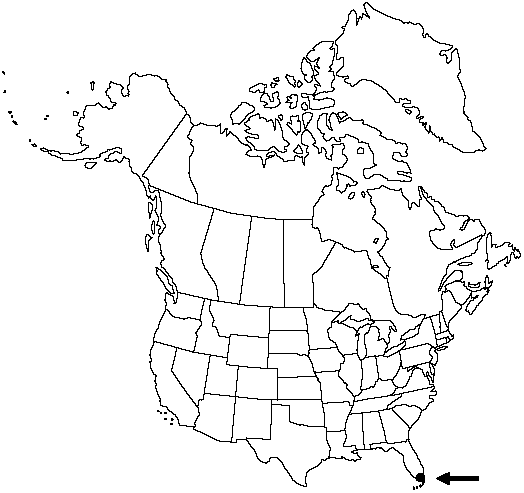Difference between revisions of "Selaginella eatonii"
Ferns Trop. Florida 67. 1918.
FNA>Volume Importer |
imported>Volume Importer |
||
| (7 intermediate revisions by 2 users not shown) | |||
| Line 8: | Line 8: | ||
}} | }} | ||
|common_names=Eaton's spike-moss | |common_names=Eaton's spike-moss | ||
| + | |special_status={{Treatment/ID/Special_status | ||
| + | |code=C | ||
| + | |label=Conservation concern | ||
| + | }} | ||
|basionyms= | |basionyms= | ||
|synonyms={{Treatment/ID/Synonym | |synonyms={{Treatment/ID/Synonym | ||
|name=Diplostachyum eatonii | |name=Diplostachyum eatonii | ||
|authority=(Hieronymus ex Small) Small | |authority=(Hieronymus ex Small) Small | ||
| + | |rank=species | ||
}} | }} | ||
|hierarchy=Selaginellaceae;Selaginella;Selaginella subg. Stachygynandrum;Selaginella eatonii | |hierarchy=Selaginellaceae;Selaginella;Selaginella subg. Stachygynandrum;Selaginella eatonii | ||
| Line 20: | Line 25: | ||
}}<!-- | }}<!-- | ||
| − | --><span class="statement" id="st- | + | --><span class="statement" id="st-undefined" data-properties=""><b>Plants </b>terrestrial, forming tiny (1–4 cm), dense clumps. <b>Stems</b> short-creeping, unbranched or few-forked, flat, not articulate, glabrous. <b>Rhizophores</b> axillary, 0.02–0.04 mm diam. <b>Leaves</b> delicate, papery. <b>Lateral</b> leaves spreading, well spaced or crowded toward stem tip, green, ovate to ovate-oblong, 1–1.5 × 0.5–0.9 mm; base rounded; margins transparent, serrate; apex acute. <b>Median</b> leaves lanceolate, 0.8–1.2 × 0.3–0.35 mm; base oblique; margins transparent, serrate; apex bristled; bristle to 1/3 length of leaf. <b>Strobili</b> solitary, 2–3 mm; sporophylls ovate-lanceolate, strongly keeled toward tip, keel dentate, base glabrous, margins serrate, apex long-acuminate.</span><!-- |
-->{{Treatment/Body | -->{{Treatment/Body | ||
| Line 26: | Line 31: | ||
|elevation=0 m | |elevation=0 m | ||
|distribution=Fla.;West Indies in the Bahamas. | |distribution=Fla.;West Indies in the Bahamas. | ||
| − | |discussion=<p>Selaginella eatonii is a minute species, easy to distinguish by its long-bristled leaf apex, iridescent leaf surface, and somewhat transparent sporophylls on the underside of the stem. It does not have any close relatives among the species in the flora. Selaginella eatonii may best be placed within subg. Heterostachys, with which it shares flattened strobili, keeled sporophylls, and a partial laminar flap on the sporophylls. Selaginella eatonii does not have strongly dimorphic sporophylls or a very well-defined laminar flap, and therefore I prefer to treat it here with the other heterophyllous species of subg. Stachygynandrum until a detailed study of subg. Heterostachys can be made.</p><!-- | + | |discussion=<p><i>Selaginella eatonii</i> is a minute species, easy to distinguish by its long-bristled leaf apex, iridescent leaf surface, and somewhat transparent sporophylls on the underside of the stem. It does not have any close relatives among the species in the flora. <i>Selaginella eatonii</i> may best be placed within subg. Heterostachys, with which it shares flattened strobili, keeled sporophylls, and a partial laminar flap on the sporophylls. <i>Selaginella eatonii</i> does not have strongly dimorphic sporophylls or a very well-defined laminar flap, and therefore I prefer to treat it here with the other heterophyllous species of subg. Stachygynandrum until a detailed study of subg. Heterostachys can be made.</p><!-- |
--><p>Of conservation concern.</p> | --><p>Of conservation concern.</p> | ||
|tables= | |tables= | ||
| Line 36: | Line 41: | ||
-->{{#Taxon: | -->{{#Taxon: | ||
name=Selaginella eatonii | name=Selaginella eatonii | ||
| − | |||
|authority=Hieronymus ex Small | |authority=Hieronymus ex Small | ||
|rank=species | |rank=species | ||
| Line 49: | Line 53: | ||
|publication title=Ferns Trop. Florida | |publication title=Ferns Trop. Florida | ||
|publication year=1918 | |publication year=1918 | ||
| − | |special status= | + | |special status=Conservation concern |
| − | |source xml=https:// | + | |source xml=https://bitbucket.org/aafc-mbb/fna-data-curation/src/2e0870ddd59836b60bcf96646a41e87ea5a5943a/coarse_grained_fna_xml/V2/V2_21.xml |
|genus=Selaginella | |genus=Selaginella | ||
|subgenus=Selaginella subg. Stachygynandrum | |subgenus=Selaginella subg. Stachygynandrum | ||
|species=Selaginella eatonii | |species=Selaginella eatonii | ||
| − | |||
| − | |||
| − | |||
| − | |||
| − | |||
| − | |||
| − | |||
| − | |||
| − | |||
| − | |||
| − | |||
| − | |||
| − | |||
| − | |||
| − | |||
| − | |||
| − | |||
| − | |||
| − | |||
| − | |||
| − | |||
| − | |||
| − | |||
| − | |||
| − | |||
| − | |||
| − | |||
| − | |||
| − | |||
| − | |||
| − | |||
| − | |||
}}<!-- | }}<!-- | ||
-->[[Category:Treatment]][[Category:Selaginella subg. Stachygynandrum]] | -->[[Category:Treatment]][[Category:Selaginella subg. Stachygynandrum]] | ||
Latest revision as of 21:22, 5 November 2020
Plants terrestrial, forming tiny (1–4 cm), dense clumps. Stems short-creeping, unbranched or few-forked, flat, not articulate, glabrous. Rhizophores axillary, 0.02–0.04 mm diam. Leaves delicate, papery. Lateral leaves spreading, well spaced or crowded toward stem tip, green, ovate to ovate-oblong, 1–1.5 × 0.5–0.9 mm; base rounded; margins transparent, serrate; apex acute. Median leaves lanceolate, 0.8–1.2 × 0.3–0.35 mm; base oblique; margins transparent, serrate; apex bristled; bristle to 1/3 length of leaf. Strobili solitary, 2–3 mm; sporophylls ovate-lanceolate, strongly keeled toward tip, keel dentate, base glabrous, margins serrate, apex long-acuminate.
Habitat: Hammocks and sink holes in limestone soil
Elevation: 0 m
Distribution

Fla., West Indies in the Bahamas.
Discussion
Selaginella eatonii is a minute species, easy to distinguish by its long-bristled leaf apex, iridescent leaf surface, and somewhat transparent sporophylls on the underside of the stem. It does not have any close relatives among the species in the flora. Selaginella eatonii may best be placed within subg. Heterostachys, with which it shares flattened strobili, keeled sporophylls, and a partial laminar flap on the sporophylls. Selaginella eatonii does not have strongly dimorphic sporophylls or a very well-defined laminar flap, and therefore I prefer to treat it here with the other heterophyllous species of subg. Stachygynandrum until a detailed study of subg. Heterostachys can be made.
Of conservation concern.
Selected References
None.